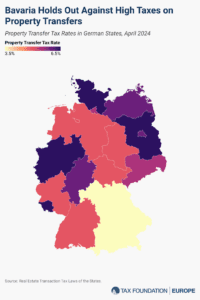
Tax Reform Is Key to Ukraine’s Economic Health, Now and after the War
5 min readBy: ,The European Council will meet this week to consider the status of Ukraine’s European Union membership application. Some Member States are skeptical that EU funds will be used properly in a former Soviet country known for corruption, while others are concerned about the impact of Ukraine’s EU membership on their own access to EU money. Without concrete solutions to these concerns, Ukraine’s EU membership bid could face public backlash across the EU.
So, what historical lessons of wartime finance can Ukrainian and EU policymakers learn to put Ukraine’s economy on a path to success during, and especially after, the war?
How Are Wars Financed?
Governments have used four basic methods to finance long-term wars:
- Raising current taxA tax is a mandatory payment or charge collected by local, state, and national governments from individuals or businesses to cover the costs of general government services, goods, and activities. rates or implementing new taxes
- Debt financing through borrowing or selling war bonds
- Reducing non-defense spending
- Printing money, or effectively monetizing the war
Most governments have relied on a combination of all four. Ukraine has mostly avoided the first—raising taxes—and has relied on borrowing, cutting non-defense spending, and printing money. Financial aid from allies has made up the difference.
What Ukraine Has Gotten Right
Ukraine was right to maintain its low-rate income taxes. European history shows that wars have been a catalyst for progressive taxA progressive tax is one where the average tax burden increases with income. High-income families pay a disproportionate share of the tax burden, while low- and middle-income taxpayers shoulder a relatively small tax burden. systems. For example, World War I transformed modest, often single-digit, income taxes into highly progressive tax regimes. World War II turned these progressive “class taxes” into “mass taxes” as lower and middle-class workers were brought into the system. After the war, many European countries maintained these high taxes to fund the growing welfare state rather than pay down the wartime debt.
Ukraine has smartly avoided taxing wartime profits. During both world wars, many countries enacted “wartime profits” taxes on businesses to capture “excess” profits earned from government contracts and wartime production. However, these taxes stifled innovation and led to needless business spending to minimize “excess” profits.
InflationInflation is when the general price of goods and services increases across the economy, reducing the purchasing power of a currency and the value of certain assets. The same paycheck covers less goods, services, and bills. It is sometimes referred to as a “hidden tax,” as it leaves taxpayers less well-off due to higher costs and “bracket creep,” while increasing the government’s spending power. is an inevitable consequence of war and is difficult to wring out of the economy during peacetime. Most countries have tried to curb wartime inflation by imposing wage and price controls. Fortunately, Ukraine has avoided such measures. Europe’s post-World War II recovery did not begin until countries relaxed their command-and-control regimes. And inflation is moderating in Ukraine; the IMF says inflation will slow this year to under 18 percent and drop to about 13 percent next year.
What Ukraine Has Gotten Wrong
Ukraine’s debt-to-GDP ratio has soared, much of it owed to other countries or banks. Large wartime debts can burden citizens and slow post-war economic growth. By one account, World War II left Britain “the greatest debtor in the history of the world,” and Germany’s debt was four times its national income. The goal of war is to protect a country’s sovereignty, but borrowing from abroad weakens that sovereignty.
Donor countries should avoid lending Ukraine more money, which will only slow its post-war recovery. Grants are the better option.
Ukraine has under-utilized “war bonds” to fund the government. It should consider launching a major campaign to raise funds from its citizens and ex-pats.
Lessons from the Marshall Plan
The U.S. Marshall Plan following World War II is often credited for rebuilding Europe after the war. However, studies show that the Marshall Plan’s impact was much more nuanced than what many Americans and Europeans have been taught.
Most post-war rebuilding in Europe was self-financed. The problem Europe faced was that inflation and price controls had discouraged production, created black markets, and caused mass shortages of food and basic goods. What the Marshall Plan funds did was provide the liquidity governments needed to abolish the price and wage controls that had paralyzed economic activity.
Moreover, Marshall Plan grants were modest and time-limited for four years. In most countries, the aid comprised roughly 2.5 percent of GDP and was conditioned on trade liberalization and economic integration. The U.S. found it difficult to enforce monetary and fiscal targets, but encouraging open markets and trade proved more important to Europe’s recovery.
The lessons for the EU are to time-limit post-war financial aid and not micromanage Ukraine’s recovery. It should set achievable goals for Ukraine to create a functioning market economy built on a simple and competitive tax system.
What Should Ukraine Do?
Ukraine should prepare for recovery while addressing the immediate financial burdens—because the true costs of the war do not end when the shooting stops. There will be considerable costs of reconstruction, caring for wounded veterans, integrating veterans into the workforce, and helping refugees. Paying for these costs will require a growing and vibrant economy.
Ukraine should put growth, competitiveness, and higher living standards over maximizing revenues. In other words, it should put growing the private sector over the needs of the public sector. This means ignoring the recommendations of the IMF and other international organizations that prioritize “resource mobilization” over economic growth.
The various flat taxAn income tax is referred to as a “flat tax” when all taxable income is subject to the same tax rate, regardless of income level or assets. models pioneered by countries such as Bulgaria, Estonia, Latvia, and Slovakia are better suited to Ukraine’s needs than Western European tax systems. Because these tax systems are simple and easy to both administer and comply with, they minimize opportunities for corruption, influence peddling, and evasion. They are also pro-growth.
Ukraine is currently considering a plan modeled on the Bulgarian flat tax—the so-called 10-10-10 reform plan. The proposed regime would levy a uniform 10 percent personal income tax, corporate income taxA corporate income tax (CIT) is levied by federal and state governments on business profits. Many companies are not subject to the CIT because they are taxed as pass-through businesses, with income reportable under the individual income tax. , and value-added tax. According to economist Simeon Djankov, the Bulgarian flat tax shrank the informal economy by two-thirds, made the tax system more equitable, and eased administration.
Ukraine could also consider the Estonian distributed profits taxA distributed profits tax is a business-level tax levied on companies when they distribute profits to shareholders, including through dividends and net share repurchases (stock buybacks). , which Poland is in the process of implementing. Either approach can address the complex challenges Ukraine faces. These simplified tax systems will boost Ukraine’s economy by rewarding entrepreneurship, capital investment, and innovation.
Unfortunately, Ukraine is not the first European country to make difficult fiscal trade-offs during wartime. However, there are better and worse ways to raise government revenue and stimulate economic growth. If Ukraine is going to win the war and thrive as a future contributing member of the European Union, a pro-growth tax reform is essential to reduce opportunities for corruption, increase investment, and generate stable government revenue for a post-war recovery.
Stay informed on the tax policies impacting you.
Subscribe to get insights from our trusted experts delivered straight to your inbox.
Subscribe
